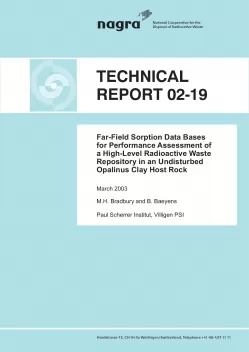
Technical Report NTB 02-19
Far-Field Sorption Data Bases for Performance Assessment of a High-Level Radioactive Waste Repository in an Undisturbed Opalinus Clay Host Rock
An Opalinus Clay formation in the Zücher Weinland is under consideration by Nagra as a potential location for a high-level and long-lived intermediate-level radioactive waste repository. Performance assessment studies will be performed for this site and the purpose of this report is to describe the procedures used to develop sorption data bases appropriate for an undisturbed Opalinus Clay host rock which are required for such safety analysis calculations.
In tight, low water content argillaceous rock formations such as Opalinus Clay, there is uncertainty concerning the in situ pH/PCO2. In order to take this intrinsic uncertainty into account porewater chemistries were calculated for a reference case, pH = 7.24, and for two other pH values, 6.3 and 7.8. Sorption data bases are given for the three cases.
The basis for the sorption data bases is "in-house" sorption measurements for Cs(I), Sr(II), Ni(II), Eu(III), Sn(IV), Se(IV), Th(IV) and I(-I) carried out on Opalinus Clay samples from Mont Terri (Canton Jura) since at the time the experiments were performed no core samples from the Benken borehole (Zücher Weinland) were available. The Opalinus Clay at Mont Terri and Benken are part of the same geological formation.
Despite having directly measured data for the above key radionuclides, some of the required distribution ratios (Rd) used to generate the sorption data bases still came from the open literature. An important part of this report is concerned with describing the procedures whereby these selected literature Rd values were modified so as to apply to the Benken Opalinus Clay mineralogy and groundwater chemistries calculated at the three pH values given above. The resulting Rd values were then further modified using so-called Lab – Field transfer factors to produce sorption values which were appropriate to the in situ bulk rock for the selected range of water chemistry conditions.
Finally, it is important to have some appreciation of the uncertainties associated with the selected Rd values in the sorption data bases. An attempt has been made in the report to move away from the unsatisfactory "realistic/conservative" terminology and to develop a procedure for estimating uncertainty in a transparent and traceable manner.
